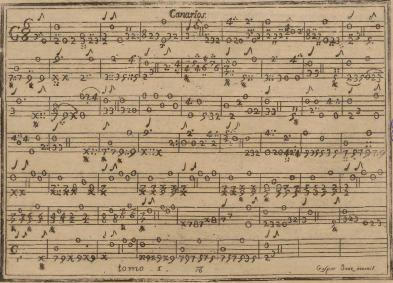Canarios by Gaspar Sanz
![]() Canarios is a work for the five course
baroque Spanish guitar, published as part
of Instrucción de música sobre la
guitarra española. The source I used from the
Biblioteca Nacional de España was dated 1697; but the
first volume of the three volume set may have been published
separately in 1674 because I've seen that date
associated with Canarios in several
secondary sources. Although the notes of the five courses of the
baroque guitar are the same as those of the upper five strings of
today's Spanish guitar, the way the courses were tuned with
respect to one another was inconsistent. A course may have been
tuned an octave apart or in unison. When tuned an octave apart,
which string in a course was higher or lower would vary.
Furthermore, the lower two courses were sometimes tuned in unison
an octave higher (on today's guitar that would be equivalent to
tuning the open A string
to A on the second fret of the
open G string).
Canarios is a work for the five course
baroque Spanish guitar, published as part
of Instrucción de música sobre la
guitarra española. The source I used from the
Biblioteca Nacional de España was dated 1697; but the
first volume of the three volume set may have been published
separately in 1674 because I've seen that date
associated with Canarios in several
secondary sources. Although the notes of the five courses of the
baroque guitar are the same as those of the upper five strings of
today's Spanish guitar, the way the courses were tuned with
respect to one another was inconsistent. A course may have been
tuned an octave apart or in unison. When tuned an octave apart,
which string in a course was higher or lower would vary.
Furthermore, the lower two courses were sometimes tuned in unison
an octave higher (on today's guitar that would be equivalent to
tuning the open A string
to A on the second fret of the
open G string).
 |
The original tablature contains double vertical lines every four measures. I've reproduced these as dashed double-bar lines.
Tuning expectations are not always conveyed in the tablature of the time. Coupled with the use of treble strings where the modern guitar has bass strings, it becomes impossible to produce a completely faithful transcription for the modern classical guitar. Some transcriptions introduce additional notes, such as using a dropped-D tuning and playing the dropped-D for extra volume. My transcription attempts to limit itself as much as is practical to what's actually in Sanz's original tablature. As with most other transcriptions, however, I've had to surrender to the nature of the guitar and drop most of the open A♮'s an octave to make the piece both playable and agreeable. I have also omitted the ornamentation appearing in the tablature (one trill and what appear to be several vibrato indications).
On the baroque guitar, the fifth course was tuned an octave higher and the fourth course was tuned in unison an octave apart, with the higher string closer to the thumb. When you try to play parts of the piece with the A♮ and D♮ an octave higher, you get a glimpse of what the piece was intended to sound like on the baroque guitar. But it's simply not practical to play the entire piece that way without restringing your guitar. And even so, the fourth string will never capture the octave interval of the baroque guitar's fourth course. In the end, any rendering of this piece on the classical guitar is truly an arrangement catering to the sound of the Spanish guitar in addition to a transcription.
Remember that Canarios is a dance and should be played with attention to rhythm. When learning the piece, do not become obsessed with trying to make the bass notes ring only as long as indicated. As long as you get the rhythms right, the piece will sound just fine whether or not a bass note rings longer than notated.
| Sheet Music |
|---|
| Canarios.pdf |
| Revision History | ||
|---|---|---|
| 2018-11-02 | ||
|
Corrected bass eighth notes in measure 36. The tablature clearly contains A D A where I notated D A D. The error was brought to my attention by a person who contacted me via email and to whom I am extremely grateful. I apologize to any and all for my mistake. | ||
| 2018-08-14 | ||
|
Corrected A♮ in measure 9 that should have been an A♮', an octave higher. I introduced this error while renotating using LilyPond. Many thanks to the person who identified the mistake and brought it to my attention. | ||
| 2018-05-28 | ||
|
Renotated using LilyPond, revisiting original baroque guitar tablature and making some adjustments. Added dashed double-bar lines where double lines are present in original tablature. Changed A♮'' in measure 16 from eighth note to quarter note. Removed repeated ending. Changed F♯'' in measure 60 from quarter note to dotted half note. Removed right-hand fingering. | ||
| 2013-10-11 | ||
|
Added right-hand fingering. The fingering is excessive and distracting for sight-reading. Still, it assists less experienced players to work out a viable way of playing the piece. By no means is the presented fingering the only way to play the piece. I had to unlearn several different ways I previously played the piece before arriving at the fingering in this revision. This fingering attempts to minimize using the same finger twice in a row (except for the thumb and when playing partial chord sequences), allowing the right hand to make fluid motions avoiding tension and fatigue. | ||
| Sheet Music | Sheet Music w/o Tablature |
|---|---|
| Canarios-sib.pdf | Canarios-sib-notab.pdf |
